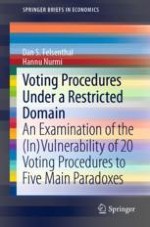This book deals with 20 voting procedures used or proposed for use in elections resulting in the choice of a single winner. These procedures are evaluated in terms of their ability to avoid five important paradoxes in a restricted domain, viz., when a Condorcet winner exists and is elected in the initial profile. Together with the two companion volumes by the same authors, published by Springer in 2017 and 2018, this book aims at giving a comprehensive overview of the most important advantages and disadvantages of voting procedures thereby assisting decision makers in the choice of a voting procedure that would best suit their purposes.
